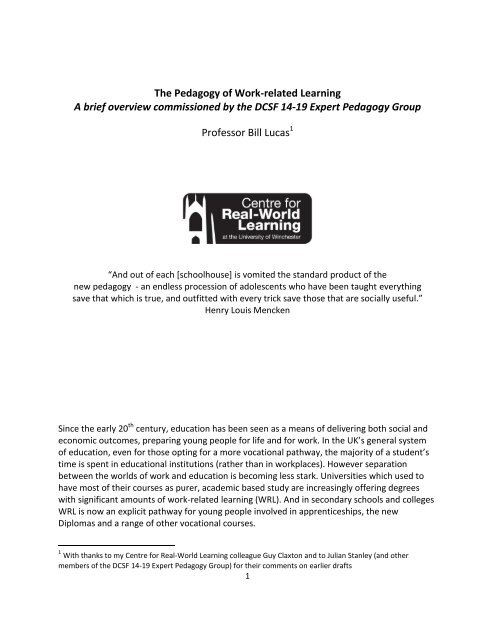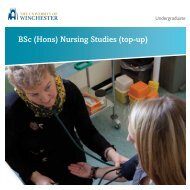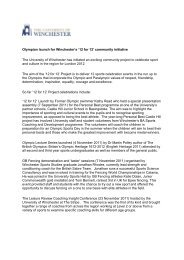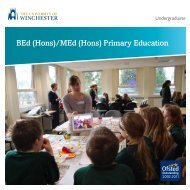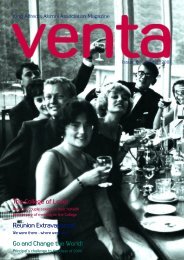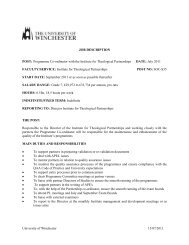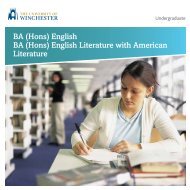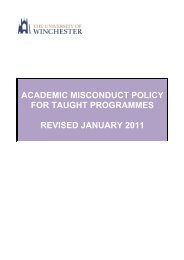The Pedagogy of Work-based Learning - University of Winchester
The Pedagogy of Work-based Learning - University of Winchester
The Pedagogy of Work-based Learning - University of Winchester
You also want an ePaper? Increase the reach of your titles
YUMPU automatically turns print PDFs into web optimized ePapers that Google loves.
This short paper seeks to describe some <strong>of</strong> the main traditions in the pedagogy <strong>of</strong> work-relatedlearning (WRL). <strong>The</strong> focus is primarily on 14-19 where WRL becomes especially important foryoung people and where there are a number <strong>of</strong> current policy developments taking place.While some reference is made to more general thinking about work-<strong>based</strong> learning (in otherwords the learning or training undertaken by adults), the emphasis is on WRL for 14-19 yearolds, in work experience, on apprenticeships and undertaking vocational courses. An underlyingprinciple throughout the paper is that, as Kurt Lewin observed: “<strong>The</strong>re is nothing so practical asa good theory” 2 . In other words, that, in becoming a better learner or teacher, it may be usefulto have clearer and more accurate mental models <strong>of</strong> what is going on beneath the surface, andthat such understanding may be practically useful.Initially intended to initiate discussion among the DCSF 14-19 Expert <strong>Pedagogy</strong> Group 3 , thepaper is also designed to stimulate discussion between policy-makers, researchers andpractitioners about the relative benefits <strong>of</strong> using different pedagogies in different WRLsituations. <strong>The</strong> paper is necessarily limited in scope as it has involved a short rather thanexhaustive review <strong>of</strong> the literature.<strong>Pedagogy</strong> in generalInternationally, as the quotation from the USA which begins this paper illustrates, pedagogy hasnot always had a good name! Too <strong>of</strong>ten it is associated either with new-fangled methods orwith an overly abstract view <strong>of</strong> what practitioners actually do when they are actually teaching(the “socially useful” jibe <strong>of</strong> the Mencken quotation) In England we are, arguably, even morereticent than other European countries with regard to pedagogy although there has <strong>of</strong>ten beentalk about “teaching methods”. So, nearly thirty years ago Brian Simon lamented our lack <strong>of</strong>interest in pedagogy. 4 In 2004 Robin Alexander was driven to make a similar complaint, thistime with regard to the Primary curriculum 5 . Most recently there has been an explicit attemptto underpin 14-19 policy with pedagogical thinking in <strong>The</strong> Diploma and its pedagogy. 6 And theformation <strong>of</strong> the Department for Children Schools and Families 14-19 Expert <strong>Pedagogy</strong> Groupwhich commissioned this paper is a further indication <strong>of</strong> a resurgence <strong>of</strong> interest in matterspedagogical.<strong>The</strong>re are, <strong>of</strong> course, many different kinds <strong>of</strong> workplaces, from production lines to the creativeindustries, social enterprises to global companies and we should not be surprised if learningwithin these different kinds <strong>of</strong> organizations is very different. It will be interesting to see2 Lewin, Kurt (1951) Field theory in social science; selected theoretical papers. Cartwright, Dorwin (Ed.) New York:Harper & Row3 <strong>The</strong> DCSF 14-19 Expert <strong>Pedagogy</strong> Group was created by the Department for Children Schools and Families in 20094 Simon, Brian (1981) Why no pedagogy in England? In Simon, Brian and Taylor W (Eds) Education in the eighties:the central issues. London: Batsford, 124-1455 Alexander, Robin (2004) Still no pedagogy? Principle, pragmatism and compliance in primary educationCambridge Journal <strong>of</strong> Education, Vol 34, No 1, 7-336 Centre for Education and Industry, <strong>University</strong> <strong>of</strong> Warwick (2008) <strong>The</strong> Diploma and its pedagogy London: QCA2
whether there are any commonly applicable principles <strong>of</strong> pedagogy which may be useful inworkplaces and in the educational institutions which <strong>of</strong>fer WRL and which are different fromtraditional school-<strong>based</strong> pedagogies.A definition <strong>of</strong> work-related <strong>Learning</strong> (WRL)For the purpose <strong>of</strong> this paper, WRL is considered to be a broader concept than work-<strong>based</strong> orwork-place learning. Practical examples <strong>of</strong> WRL include work experience, apprenticeship, workshadowing, service learning, community-<strong>based</strong> projects, vocational courses, Diplomas,simulations, and the teaching <strong>of</strong> wider employability and real world skills. WRL involves learningfor, at and through work. It includes learning which is formal and informal, assessed and notassessed. WRL can be experienced in a range <strong>of</strong> settings and learned in a variety <strong>of</strong> ways. <strong>The</strong>formal DCSF definition <strong>of</strong> WRL is “planned activity that uses the context <strong>of</strong> work to developknowledge, skills and understanding useful in work, including learning through the experience<strong>of</strong> work, learning about work and working practices, and learning the skills for work.” 7 But thesedescriptions do not quite do the complex subject <strong>of</strong> WRL justice. For it sits on a continuumbetween classroom-<strong>based</strong> and work-<strong>based</strong> learning, <strong>of</strong>ten explicitly requiring transfer <strong>of</strong>learning between work and education contexts.Given that WRL is provided in England by and at a range <strong>of</strong> institutions - schools, colleges,universities, independent learning providers and workplaces - our interest is primarily in theinterface between these organizations and in what each can do to ensure that WRL is mosteffective. <strong>The</strong> supposition is that, if we understand more about the pedagogy <strong>of</strong> WRL, we maybe able to acquire practically useful insights about learners, learning, teaching, attitudes toknowing and doing, and the affordances <strong>of</strong> and demands <strong>of</strong> the different contexts in which WRLtakes place. WRL became a statutory requirement <strong>of</strong> the Key Stage 4 curriculum fromSeptember 2004 8 .Characteristics <strong>of</strong> <strong>Work</strong>-related <strong>Learning</strong> (WRL)Much WRL takes place in contexts whose primary purpose is not teaching or learning andwhere the “teaching” may be done by many different people who are not teachers. As hasalready been observed, not all WRL takes place at work, although a significant amount <strong>of</strong> it –apprenticeship and elements <strong>of</strong> diplomas are two obvious examples - clearly does. <strong>Work</strong>environments and cultures are very different, and various commentators have attempted todescribe the complexity <strong>of</strong> workplace contexts.7 DCSF (2008) <strong>The</strong> <strong>Work</strong>-related <strong>Learning</strong> Guide – First edition A guidance document for employers, schools,colleges, students and their parents and carers8 For more on the progress <strong>of</strong> WRL in schools, see a useful study <strong>of</strong> 2007, <strong>Work</strong>-related learning at key stage 4 Firstreplication study: a QCA-commissioned report on the development <strong>of</strong> work-related learning in the three years sinceSeptember 20043
Michael Eraut 9 , usefully summarises the factors which may facilitate or inhibit learning in aworkplace. <strong>The</strong>se include: the extent to which there are transactions with other outside people the range and variety <strong>of</strong> activities the extent to which activities allow flexible and discretionary decisions the scope and demand for inventiveness, problem-solving and creativity, individuallyand in teams the degree to which there are opportunities for planning, reviewing and strategicthinking the degree to which it is possible for individuals to perform to the best <strong>of</strong> theircompetence, and the nature <strong>of</strong> formal and informal communications within theworkplace.Eraut also found that two specific factors above others were influential 10 – the “micro-culture<strong>of</strong> the workplace” and “how a person is managed”. Each <strong>of</strong> these can be hugely pro- or antilearning.It would seem logical to assume that, within workplaces, different pedagogies may be requireddepending on the: different kinds <strong>of</strong> learners and their prior experiences subject being learned available resources and, <strong>of</strong> course context.Within schools and colleges, the primary locations <strong>of</strong> WRL provided by educational institutions,a range <strong>of</strong> pedagogies are utilized. Some <strong>of</strong> these are explicit (as with formative approaches tolearning epitomized by Assessment for <strong>Learning</strong> 11 ). Others are much less so, as for example, inthe range <strong>of</strong> approaches that can be found to the organization <strong>of</strong> work experience or in theways that colleges deliver components <strong>of</strong> apprenticeships.A classic description <strong>of</strong> the difference between learning in educational institutions and learningelsewhere (at work and at home, for example) was provided by Lauren Resnick 12 more thantwenty years ago. Toni Griffiths and David Guile helpfully summarise Resnick’s thinking 13 :9 Eraut, Michael (2004) Deconstructing apprenticeship learning: what factors affect its quality? In New Approachesto Vocational Education in Europe Oxford: Symposium Books10 Op. cit.11 See http://www.qcda.gov.uk/4334.aspx for a summary <strong>of</strong> the principles developed by Paula Black and DylanWiliam and now interpreted by QCDA12 Resnick, Lauren (1987) <strong>Learning</strong> in school and out, Educational Researcher, Vol 16, 13-4013 Figure 1 is adapted from Griffiths, Toni and Guile, David, <strong>Pedagogy</strong> in work-<strong>based</strong> contexts in Mortimer, Peter(1999) Understanding <strong>Pedagogy</strong> and its impact on learning. London: Sage Publications4
Figure 1 – Different approaches to learning<strong>Learning</strong> in school and collegeDecontextualisedSecond-handExtrinsically motivatedOften individualisticAssessed by othersFormal<strong>Learning</strong> at work and at homeReal contextFirst-handIntrinsically motivatedOften collaborativeSelf-assessedInformalA key question, and one asked by a series <strong>of</strong> Teaching and <strong>Learning</strong> Research Programmeseminars in 2005 and 2006 14 , is: “What forms <strong>of</strong> pedagogy can most effectively mobilizelearning across domains, and for what purposes?” 15 In other words, given that a characteristic<strong>of</strong> WRL is that it occurs across a number <strong>of</strong> different contexts, which pedagogies are mosteffective? What follows is an attempt to stimulate discussion <strong>of</strong> some possible answers to thisquestion.WRL, wherever it occurs, takes as its starting point the task associated with a particular workingpractice and, through a combination <strong>of</strong> on the job and <strong>of</strong>f the job methods, seeks to extract thelearning from this. Or it might anticipate a workplace activity and prepare learners by teachingthem or allowing them to discover some core aspects <strong>of</strong> theory, processes and practicesbeforehand. In this WRL is different from general education and learning which is still largelypredicated on areas <strong>of</strong> knowledge, frequently described as “subjects”.Where a student in a school learns aspects <strong>of</strong> Geography or Biology, an apprentice might belearning about aspects <strong>of</strong> farming which require both geographical and biological knowledge. InWRL the eventual application is likely to influence the methods by which learners areintroduced to key concepts and skills. Arguably the second <strong>of</strong> these “models” <strong>of</strong> learning hasmuch to commend it in pedagogical terms, whereas the subject-<strong>based</strong> tradition, the first <strong>of</strong> thetwo just mentioned, may leave the learner uncertain about how what they have learned canbest be applied (other than in tests or examinations).Indeed this shift away from a narrow focus on subjects has been recognized for youngerlearners in the broader Programmes <strong>of</strong> <strong>Learning</strong> and the accompanying Essentials for <strong>Learning</strong>and Life that make up the new Primary curriculum 16 and in other contributions to the policydebate 17 . Of course in good teaching and learning such crude polarizations are seldom present14 See http://crll.gcal.ac.uk/tlrp/tlrp_seminar.htm15 See Edwards, Richard and Miller, Kate (2007) Putting the context into learning <strong>Pedagogy</strong>, Culture and SocietyVol 15, no 3, 263-274 for a summary <strong>of</strong> many <strong>of</strong> these issues16 Rose, Sir Jim (2009) Independent Review <strong>of</strong> the Primary Curriculum: Final Report London: HMSO17 Lucas, Bill and Claxton, Guy (2009) Wider skills for learning; what are they, how can they be cultivated, how couldthey be measured and why are they important for innovation? London: NESTA5
as the educators concerned select those pedagogies and methods most appropriate for thelearning to be undertaken.If “pedagogy” seems too general a term to describe what goes on in WRL, Figure 2 <strong>of</strong>fers somespecific examples <strong>of</strong> the kinds <strong>of</strong> methods which tend to be used.Figure 2 - Some examples <strong>of</strong> <strong>Work</strong>-related <strong>Learning</strong> (WRL) methods 18<strong>Learning</strong> by watching. <strong>The</strong> importance <strong>of</strong> learning by observation is <strong>of</strong>tenunderestimated and it is a key element <strong>of</strong> much WRL. Young children are extremelygood at it, though they <strong>of</strong>ten get ‘educated’ out <strong>of</strong> it, to their detriment. 19 Brains arebuilt to learn by observation, and they do not stop doing it when children becometeenagers. 20<strong>Learning</strong> by practising. Practising is a complex set <strong>of</strong> learnable learning skills. <strong>The</strong>literature shows how different kinds <strong>of</strong> practice are optimal for different learning’jobs’. 21<strong>Learning</strong> by imitating. Observation and practice combine most powerfully in imitation:the attempt to emulate an observed performance. <strong>The</strong> human brain is designed tolearn by imitation, and this disposition provides vital social ‘glue’ that holds groupstogether, as well as being one <strong>of</strong> the apprentice’s most powerful learning methods. 22<strong>Learning</strong> through feedback. Students learn faster if they can ‘hear’ feedback as a usefulguide to improvement, rather than as a negative evaluation <strong>of</strong> self-worth. Thisdisposition can be cultivated through conversation and modelling. 23<strong>Learning</strong> by chatting. Much useful learning happens in informal conversation betweenpeers, and between more and less experienced students. <strong>The</strong> exchange <strong>of</strong> peerinformation and ideas remains a central learning strategy throughout working life inmany sectors. 2418 This set <strong>of</strong> examples is largely adapted from Lucas, Bill, Claxton, Guy and Webster, Rob (2010) Mind the gap;research and reality in practical and vocational education. London: Edge19 Rog<strong>of</strong>f, Barbara (2003) <strong>The</strong> Cultural Nature <strong>of</strong> Human Development, New York: Oxford <strong>University</strong> Press20 Hurley, Susan and Chater, Nick (eds) (2005) Perspectives on Imitation, Vols I and II, Cambridge MA: Bradford/Massachusetts Institute <strong>of</strong> Technology Press21 Lavallee, David, Williams, Jean and Jones, Marc (eds) (2008), Key Studies in Sport and Exercise Psychology,Maidenhead: McGraw-Hill Education22 Hurley, Susan and Chater, Nick (eds) (2005) Perspectives on Imitation, Vols I and II, Cambridge MA: Bradford/Massachusetts Institute <strong>of</strong> Technology Press23 Dweck, Carol (2006) Mindset; the new psychology <strong>of</strong> success New York: Ballantine24 Mercer, Neil (2000) Words and Minds: How We Use Language to Think Together London: Routledge6
<strong>Learning</strong> by teaching and helping. Apprentices <strong>of</strong>ten act as teachers as well as learners.Alison Fuller and Lorna Unwin 25 describe apprentices claiming to learn a good deal fromtheir efforts to help other people, as well as deriving satisfaction and self-esteem.<strong>Learning</strong> by real-world problem-solving. Problem-<strong>based</strong> learning is commonly used inWRL. Effective simulations and role-plays <strong>of</strong>fer learners the opportunity to developqualities <strong>of</strong> mind such as thinking, imagination, resilience and collaboration in theprocess <strong>of</strong> tackling genuinely difficult tasks together. 26<strong>Learning</strong> by listening, transcribing and remembering. <strong>The</strong>re are many things that anapprentice has to know and remember, and some <strong>of</strong> these can be efficiently learnedthrough drill and repetition. However this method becomes overused andcounterproductive when learners have to commit knowledge to memory that isnecessary only to pass exams, and can thereafter be safely forgotten.<strong>Learning</strong> by writing and sketching. <strong>The</strong>re is a necessary place in WRL for developing thesense <strong>of</strong> when and how it is useful to think something carefully through on paper; theability to use drafts, sketches, diagrams and models to clarify and stimulate thinking;the know-how to write necessary reports and accounts.<strong>Learning</strong> on the fly. This is a nice phrase 27 to describe the opportunistic nature <strong>of</strong> WRLwhereby learners make requests for help from whoever is available to answer theirquestions.Characteristics <strong>of</strong> 14-19 year old learners<strong>The</strong> period <strong>of</strong> teenage life on which we are focusing has specific challenges in terms <strong>of</strong>pedagogy. For in addition to understanding factors such as the content <strong>of</strong> what it to be learnedand the context in which this takes place, the young learners are themselves in a relativelyvolatile state. Young people at this age tend, quite naturally, to be risk taking and boundarypushing as they seek to develop their own identity. Knud Illeris 28 puts it like this:“All learning from the age <strong>of</strong> 12 or 13 onwards is very much orientated towards theformation <strong>of</strong> identity and can only be understood in this light…Whereas childhood is aperiod for constructive assimilative learning, youth is a period for major accommodations25 Fuller, Alison and Unwin, Lorna (2004) Young People as Teachers and Learners in the <strong>Work</strong>place: Challenging theNovice-Expert Dichotomy, International Journal <strong>of</strong> Training and Development, 8(1), 31-4126 Barell, John (2007) Problem-Based <strong>Learning</strong>: An Inquiry Approach, New York: Corwin Press27 Suggested by Beach, King and Vyas, Sapna (1998) Light pickles and heavy mustard; horizontal developmentamong students negotiating how to learn in production activity. Paper presented at the Fourth Conferences <strong>of</strong> theInternational Society for Cultural Research and Activity <strong>The</strong>ory, <strong>University</strong> <strong>of</strong> Aarhus, Denmark28 Illeris, Knud (2007) How we learn; learning and non-learning in school and beyond. Oxford: Routledge7
and transformations in which, one by one, pr<strong>of</strong>ound changes are made to the knowledgestructures and emotional patterns with regard to identity.”For some learners there is an additional challenge <strong>of</strong> low esteem in that, if they are following alearning pathway involving WRL, this may largely be because they have failed to jump overvarious academic hurdles during their school life and consequently feel in some sense secondrate.While practitioners are <strong>of</strong>ten acutely aware <strong>of</strong> this, there has not yet been enoughdiscussion <strong>of</strong> the implications <strong>of</strong> low esteem for pedagogy?On the other hand, the chance <strong>of</strong> moving into a WRL context can be a motivating force too.William Richardson sees the more adult atmosphere <strong>of</strong> work (and life in an FE college) as moremotivating for those learners who have not done well academically:“<strong>The</strong> majority <strong>of</strong> this group who want to leave school [early] have huge capacities andabilities and potential, but we have just incredibly crude institutions and structures forenabling and releasing it. So they get shunted into a low status, low prospects route andthen feel trapped and let down. But their potential could have come alive had thepedagogic environment been much richer. You see people thrive quickly when the settingchanges.” 29<strong>The</strong> clear implication <strong>of</strong> the Richardson comment is that the development <strong>of</strong> richer pedagogicenvironments for 14-19 WRL must assume more importance.Richard Pring and colleagues helpfully approach the issue <strong>of</strong> the characteristics <strong>of</strong> 14-19learners from another angle, namely by considering what a 19 year old learner might be able todo and know by age 19. <strong>The</strong> Nuffield 14-19 research 30 which he led concluded, among othermatters, that more active and practical learning <strong>of</strong> the kind found in WRL was required foreveryone.And, <strong>of</strong> course, we should not forget the fact that, in terms <strong>of</strong> learning media, the youngergeneration – and 14-19 year-olds are <strong>of</strong>ten at the leading edge <strong>of</strong> this – is adept at using ICT inways which baffle many <strong>of</strong> their teachers and mentors.Key traditions <strong>of</strong> pedagogy in WRLWhile there is much less written about the pedagogy <strong>of</strong> WRL than about more general school<strong>based</strong>education, WRL has a long history stretching back to the early days <strong>of</strong> apprenticeship inthe Middle Ages. As WRL has developed over the centuries it has also borrowed and adaptedpedagogies from other contexts. And since the 1980s, when Peter Senge coined the phrase29 Interviewed as part <strong>of</strong> research in Lucas, Bill, Claxton, Guy and Webster, Rob (2010) Mind the gap; research andreality in practical and vocational education. London: Edge30 Pring, Richard et al (2009) Education for All: the future <strong>of</strong> education and training for 14-19 year olds Oxford:Routledge8
“<strong>The</strong> <strong>Learning</strong> Organisation” to suggest that the workplace could be a specific location forlearning, there has been a new interest in understanding the socio-cultural implications <strong>of</strong>working and learning while being employed. Indeed Peter Senge 31 argues for the value <strong>of</strong> WRL:“As the world becomes more inter-connected organizations that will truly excel in thefuture will be (those)...that discover how to tap people's commitment and capacity tolearn.”What follows is a brief overview <strong>of</strong> some <strong>of</strong> the key traditions <strong>of</strong> WRL pedagogies 32 . While eachone may appear to be a discrete entity, in practice the boundaries between them are morepermeable.<strong>The</strong> Transmission MethodWithout necessarily being dignified by any specific research tradition, the idea that learningtakes place best when the teacher or tutor or expert is transmitting their knowledge to theirclass or to their pupil or to their apprentice is deeply embedded in educational history. Thisapproach to pedagogy is not unconnected to longstanding (and false) views <strong>of</strong> young learnersbeing either tabula rasa (blank slates) waiting to be “written” upon by those who know betteror “little vessels” needing to be filled up with facts chosen by the knowledgeable adult.In this model <strong>of</strong> pedagogy, the teacher is firmly in control <strong>of</strong> the knowledge that is delivered tolearners and the students demonstrate their successful acquisition <strong>of</strong> the knowledge by someform <strong>of</strong> testing. This approach can appear to be effective (as in efficient) in that maximuminformation is transmitted by an “expert” in relatively small amounts <strong>of</strong> time, with activitiesdesigned to embed knowledge. But in fact it is frequently ineffective, with learners having apassive and dependent relationship to what is being taught.In a much more positive vein, skilled expert instruction and demonstration can be an extremelyeffective means <strong>of</strong> cultivating habits <strong>of</strong> mind and <strong>of</strong> learning certain skills in learners. Indeedthis approach is at the heart <strong>of</strong> traditions <strong>of</strong> apprenticeship across the world. Klaus Nielsen, forexample, has shown how a subtle combination <strong>of</strong> instruction, observation and increasingopportunities for learner practical experimentation is a highly effective method <strong>of</strong> developingapprentice bakers 33 .31 Peter Senge (1990) <strong>The</strong> Fifth Discipline: <strong>The</strong> art and practice <strong>of</strong> the learning organization, Doubleday, New York32 <strong>The</strong>re are a number <strong>of</strong> useful existing summaries <strong>of</strong> workplace pedagogies <strong>of</strong> which Fuller, Alison and Unwin,Lorna, Developing pedagogies for the contemporary workplace, in Evans, Karen, Hodkinson, Phil and Unwin, Lorna(Eds) (2002) <strong>Work</strong>ing to Learn; transforming learning in the workplace London: Routledge is particularly useful33 Nielsen, Klaus (2008) 'Scaffold instruction at the workplace from a situated perspective', Studies in ContinuingEducation, 30: 3, 247-2619
<strong>The</strong> Humanistic ApproachAlthough developed in a therapeutic context, echoes <strong>of</strong> the thinking <strong>of</strong> Carl Rogers 34 can befound in the practice <strong>of</strong> many WRL practitioners. Often referred to as Humanist on account <strong>of</strong>his special respect for the individual learner, Rogers saw teaching not as didacticism but as akind <strong>of</strong> facilitation. All people, he believed, have the potential for growth and it is the teacher’srole to facilitate such development. In manifesting his approach Rogers considered thatteachers should be “real” (prepared to share what they are really thinking or feeling withlearners), should value the learner as an individual and should constantly strive to beempathetic in their relationship with learners.Arguably the impact <strong>of</strong> Rogers thinking on education is in his emphasis on the quality <strong>of</strong> therelationship between teacher and learner: ‘<strong>The</strong> facilitation <strong>of</strong> significant learning rests uponcertain attitudinal qualities that exist in the personal relationship between facilitator andlearner’ 35 .Experiential <strong>Learning</strong>In many ways the idea <strong>of</strong> experiential learning is related to the Humanist or person-centredtradition. As David Kolb argues: “<strong>Learning</strong> is the process whereby knowledge is created throughthe transformation <strong>of</strong> experience.” 36 First we experience something, then we observe andreflect on our experience, then we develop theories to account for what we experience andfinally we actively test out our conceptual understanding and experiment. This is theexperiential learning cycle associated with Kolb.Kolb’s theory is at least in name one <strong>of</strong> the most <strong>of</strong>ten cited with regard to WRL (indeed it isspecifically mentioned in <strong>The</strong> Diploma and its pedagogy and is part <strong>of</strong> the thinking behind theuse <strong>of</strong> the term “applied learning” in the Diploma). Perhaps because <strong>of</strong> its attractive simplicityor because <strong>of</strong> the way that, through valuing experience, it empowers an individual, Kolb’slearning cycle is widely used as an example <strong>of</strong> pedagogy in action. And there is much commonsensecontained in it. You learn how to use a lathe by using a lathe not by reading about it orbeing told about it, the argument goes.One <strong>of</strong> the most important features <strong>of</strong> Kolb’s thinking is not its emphasis on experience but itsfocus on reflection. So it is not the fact that you do something that is valuable but more thatyou may do it differently (better) as a consequence <strong>of</strong> reflecting on and “extracting the learningjuice” from the situation in which you are involved.But as a pedagogical theory, Kolb’s cyclical approach to experience can appear to be too neatwith regard to how we learn. In some cases as we will see later in this paper, Kolb is just plain34 Rogers, Carl (1969) Freedom to Learn : a view <strong>of</strong> what Education might become Columbus, OH: Merrill35 Kirschenbaum, Howard and Henderson, Valerie (Eds.) (1990) <strong>The</strong> Carl Rogers Reader, London: Constable36 Kolb, David (1984) Experiential <strong>Learning</strong>: Experience as the Source <strong>of</strong> <strong>Learning</strong> and Development. EnglewoodCliffs, N.J: Prentice-Hall10
wrong in that sometimes we learn more effectively when we develop a theoreticalunderstanding first and then test it out later in practice! Overstressing the value <strong>of</strong> experiencecan also run the risk <strong>of</strong> undervaluing the value <strong>of</strong> the teacher and neglect the pedagogicprocesses involved. It also says nothing about the context in which WRL is situated.ConstructivismPerhaps the most widely drawn upon set <strong>of</strong> pedagogies in WRL are those which are broadlydescribed as constructivist. Clearly related to both the experiential and the Humanistictraditions, constructivism puts more emphasis still on the learner’s role in creating knowledgeand new thinking. Constructivism has implications both for the role <strong>of</strong> the teacher (increasinglymore facilitative than didactic). It also articulates a pr<strong>of</strong>ound shift in the balance <strong>of</strong> power inany relationship between learners and teachers in its attitude to knowledge. Knowledge, thisview <strong>of</strong> pedagogy suggests, is something that can be created by anyone, even those who arenot experts. Indeed it is precisely the act <strong>of</strong> constructing meaning that is at the core <strong>of</strong> learning.Knowledge ceases to be something existing independently and abstractly and becomes apersonal act <strong>of</strong> meaning-making from experience.Some core principles <strong>of</strong> constructivist teaching have been summarised by John Savery andThomas Duffy 37 :1. Anchor all learning activities to a larger task or problem.2. Support the learner in developing ownership for the overall problem or task.3. Design authentic tasks.4. Design the task and the learning environment to reflect the complexity <strong>of</strong> theenvironment the learner should be able to function in at the end <strong>of</strong> the learning.5. Give the learner ownership <strong>of</strong> the process used to develop a solution.6. Design the learning environment to support and challenge the learner's thinking.7. Encourage the generation <strong>of</strong> alternative ideas, views and contexts.8. Support opportunities for reflection on both the content learned and the learningprocess throughout the learning.Whether in WRL or more generally in any learning situation, these principles resonate withmany practitioners today. <strong>The</strong>y helpfully introduce a new element in our discussions, namelythe idea <strong>of</strong> authenticity, that the learning needs to seem “real” to the learner for it to besuccessful.One aspect <strong>of</strong> authentic, constructivist pedagogy developed directly in a WRL context isnormally referred to as problem-<strong>based</strong> learning. Problem-<strong>based</strong> learning (PBL) is a pedagogicalapproach that suggests that learning is effective when the learner is empowered to undertakeresearch into real problems or challenges applying both theory and practice to developsolutions. Developed in the 1970s for the training <strong>of</strong> doctors in North America, PBL sought to37 Savery, John and Duffy, Thomas (1995) ‘Problem Based <strong>Learning</strong>: An Instructional Model and its ConstructivistFramework’, Educational Technology, 35, 31-3811
take medical education away from its abstracts by recreating the kind <strong>of</strong> real-world workenvironment into which doctors will go as part <strong>of</strong> their training. Researchers examining thisproblem-<strong>based</strong> approach found that it was at least equal to more conventional methods whenit came to medical board examinations but superior in terms <strong>of</strong> the development <strong>of</strong> clinicalproblem-solving skills 38 .Problem-<strong>based</strong> learning is intuitively attractive to WRL practitioners as it somehow replicatesthe messy real-worlds <strong>of</strong> work in which challenges abound. However grappling with problemswithout other methods being used – personal reflection and collaborative enquiry, for example– may mean that the approach is less useful 39 .A logical extension <strong>of</strong> constructivist thinking is the idea <strong>of</strong> peer learning, where learnersexplicitly seek to learn from and each other. David Boud’s description 40 makes this clear:“Students learn a great deal by explaining their ideas to others and by participating in activitiesin which they can learn from their peers”. <strong>The</strong> use <strong>of</strong> peer learning indicates a potential roledevelopment beyond the idea <strong>of</strong> teachers becoming facilitators to one where learners becometeachers. This is no mere whimsy. For it turns out that, when learners act as teachers, there is amajor impact on their educational achievement. John Hattie in his exemplary review 41 <strong>of</strong>hundreds <strong>of</strong> meta-analyses <strong>of</strong> aspects <strong>of</strong> teaching and learning puts it like this:“<strong>The</strong> remarkable feature <strong>of</strong> [all this] evidence is that the biggest effects on studentlearning occur when teachers become learners <strong>of</strong> their own teaching, and when studentsbecome their own teachers…Many <strong>of</strong> the most debated issues are the ones with the leasteffects.”It should be noted that the constructivist tradition has its critics. Paul Kirschner 42 andcolleagues, draw on current understanding <strong>of</strong> memory structures in the brain to argue thatdepriving novice learners <strong>of</strong> explicit guidance early on in a process can reduce the effectiveness<strong>of</strong> the learning. For without appropriate mental models, schema or rules, novices may struggleto integrate what they have learned with their prior knowledge and experience. So, instead <strong>of</strong>leaving learners to “flounder” in a highly experiential and minimally guided environment,Kirschner argues that giving them worked examples and process worksheets is likely to be38 Albanese, Mark and Mitchell, Sandra (1993) Problem-<strong>based</strong> learning: a review <strong>of</strong> the literature on its outcomesand implementation issues Academic Medicine, Vol 68, 52-8139 See Yeo, Roland (2008) How does learning (not) take place in problem-<strong>based</strong> activities in workplace contextsHuman Resource Development International Vol 11, No 3, 317-33040 Boud, David (2001) Introduction: Making the Move to Peer <strong>Learning</strong>. In Boud, David, Cohen, Ruth and Sampson,Jane (Eds.) Peer <strong>Learning</strong> in Higher Education: <strong>Learning</strong> from and with others London: Kogan Page Ltd41 Hattie, John (2009) Visible <strong>Learning</strong>; a synthesis <strong>of</strong> over 800 meta-analyses relating to achievement Oxford:Routledge42 Kirschener, Paul, Sweller, John and Clark, Richard (2006) Why minimal guidance during instruction does notwork: an analysis <strong>of</strong> the failure <strong>of</strong> constructivist, discovery-<strong>based</strong>, experiential and inquiry-<strong>based</strong> teachingEducational Psychologist Vol 41, 75-8612
eneficial. Practitioners may <strong>of</strong> course conclude that these aspects <strong>of</strong> pedagogy can both beusefully incorporated into WRL.WRL is a broad concept and practice. And many <strong>of</strong> the different strands <strong>of</strong> pedagogy mentionedso far can complement each other and be incorporated in WRL at 14-19. But sometimes thereare potential clashes or at least questions <strong>of</strong> concern. <strong>The</strong>se include consideration as to thetiming <strong>of</strong> formal instruction, the degree to which teachers instruct or facilitate, and, to return tothe criticism levelled by Richardson on page 8, how we can create richer pedagogicenvironments for 14-19 education more generally.Social views <strong>of</strong> learningMost learning is social or at least has a social dimension. We learn through observation,imitation and collaborative endeavour and a key influence on pedagogy in WRL and elsewhereis the work <strong>of</strong> Lev Vygotsky. 43 Knowledge, Vygotsky argues, is something that we constructsocially through our interactions with our peers and with those who are more knowledgeablethan ourselves. From Vygotsky’s translators we have acquired the idea <strong>of</strong> the ‘zone <strong>of</strong> proximaldevelopment’ (ZPD). Unlikely as it may sound, the ZPD is a very useful idea in PBL. <strong>The</strong> ZPDdescribes the difference between what a learner can do without help and what he or she mightbe able to achieve with expert support. It is at the heart <strong>of</strong> much apprenticeship, coaching andteaching. For the good teacher understands the learner’s stages <strong>of</strong> development and is able toprovide the necessary ‘scaffolding’ - tools, maxims, access to other more expert learners and s<strong>of</strong>orth - for him or her to progress and grow.Vygotsky also suggests that social interaction precedes (rather than follows) individualdevelopment: “Every function in the child’s cultural development appears twice: first, on thesocial level, and later, on the individual level; first, between people (interpsychological) andthen inside the child (intrapsychological).” 44 This also has potential application within WRL interms <strong>of</strong> the explicit valuing and legitimizing <strong>of</strong> social interaction.Jean Lave and Etienne Wenger take Vygotsky’s thinking a stage further with their idea <strong>of</strong>Communities <strong>of</strong> Practice (CoP) 45 , groups <strong>of</strong> people who are undertaking a common or similaractivity. Indeed CoP have been one <strong>of</strong> the most influential conceptualizations <strong>of</strong> WRL in the lastfew decades. <strong>The</strong> originality <strong>of</strong> the idea is in the way it suggests that learning is largely socialand largely <strong>based</strong> on our experiences <strong>of</strong> taking part in day to day living rather than mainlymodeled on some kind <strong>of</strong> classroom.43 Vygotsky, Lev (1978) Mind and society: the development <strong>of</strong> higher mental processes, Cambridge, MA: Harvard <strong>University</strong>Press44 Op. cit.45 Lave, Jean and Wenger, Etienne (1991) Situated <strong>Learning</strong> Cambridge: Cambridge <strong>University</strong> Press13
Lave and Wenger also coined a specific phrase - legitimate peripheral participation - to describethe complex and largely informal learning which takes place within a CoP as someone movesfrom the edge <strong>of</strong> the group:“Legitimate peripheral participation provides a way to speak about the relations betweennewcomers and old-timers, and about activities, artefacts and communities <strong>of</strong> knowledgeand practice. It concerns the process by which newcomers become part <strong>of</strong> a community<strong>of</strong> practice.” 46<strong>The</strong>ir research into various craft apprenticeships, such as tailoring, for example, showed howpeople learn to become experts without there being formal pedagogical processes in place asthey move from being peripheral members to fully participating members <strong>of</strong> a particularcommunity. (Although the expert tailors had cleverly worked out that apprenticeships shouldstart at the end <strong>of</strong> the process with simple activities unlikely to damage the garment, onlyworking back to the cutting, where expensive mistakes could be made, once they were moreexpert. <strong>The</strong> expert tailors had ordered the learning experiences <strong>of</strong> their apprentices accordinglyin their CoP.)<strong>The</strong> specific nature <strong>of</strong> the learning involved arise from the way that it is “situated”, in otherwords from its context. So a community <strong>of</strong> footballers or dry-stone wallers or pr<strong>of</strong>essors orgarage mechanics are situated in their places and cultures, developing processes, patterns <strong>of</strong>behavior, tools, stories and vocabularies to suit their specific needs. Significantly we are all insome kind <strong>of</strong> community <strong>of</strong> practice so whether we are in a “teaching” or “learning” role wewill have experience and knowledge <strong>of</strong> the process <strong>of</strong> becoming more expert in something tobring to any new situation.CoP goes beyond the idea <strong>of</strong> experiential learning in the way that it specifically anchors learningto social contexts; knowledge, even that gained through experience, exists in context and totalk <strong>of</strong> it in isolation from where it is used is, according to Lave and Wenger nonsensical.Alongside CoP and ultimately tracing its roots to Vygotsky is another approach to WRL knownas Activity <strong>The</strong>ory, a model or framework for understanding complex human activities (such asthose situated in a work environment). Activity <strong>The</strong>ory suggests that internal activities cannotbe understood if they are explored separately, in isolation from external activities. So toolsdeveloped in a specific work context are closely connected to and influenced by the context <strong>of</strong>that environment. Tools are influenced by the environment in which they are created andbecome a means by which learning is shared within that context. So, a landscape gardener willhave various methods for checking the levels within a garden that go beyond go beyond the use<strong>of</strong> the obvious tool, a spirit level.46 Op. cit.14
From this tradition <strong>of</strong> thinking Yrjö Engeström has developed the idea <strong>of</strong> CoP to create theconcept <strong>of</strong> “expansive learning”. Expansive learning occurs “when a community <strong>of</strong> practicebegins to analyse and transform itself.…a long-term process <strong>of</strong> re-defining the objects, toolsand social structures <strong>of</strong> the workplace”. 47 Alison Fuller and Lorna Unwin have taken thisapproach further still to describe different approaches to apprenticeship, one which they term“expansive” (which is full <strong>of</strong> opportunities for learning and development <strong>of</strong> many kinds) and theother called “restrictive” (where the constraints <strong>of</strong> the working environment and the demands<strong>of</strong> the institution leave little space for individual learning). 48As with all pedagogies there are those who point out areas <strong>of</strong> weakness in the idea <strong>of</strong> CoP.Fuller and Unwin and colleagues, for example, while broadly positive about the essence <strong>of</strong> Laveand Wenger’s thinking, helpfully remind us <strong>of</strong> its potential limitations as a theory 49 . <strong>The</strong>se areas follows:1. CoP, while useful as a way <strong>of</strong> understanding how novices progress, has less to say aboutexperts continue to learn.2. Lave and Wenger’s opposition to formal teaching is unhelpful and limiting.3. Learner identity, especially the knowledge and skills brought by new members <strong>of</strong> a CoPfrom outside is insufficiently developed.4. CoP does not acknowledge the very considerable power inequalities which exist inworkplaces and is, in this area, potentially over idealistic.Toni Griffiths and David Guile have attempted further to develop the CoP concept to overcomesome <strong>of</strong> the limitations implied so far. <strong>The</strong>y call it the “connective model <strong>of</strong> learning” 50 which ischaracterized by: an emphasis on reflexive activity (learners extracting the meaning <strong>of</strong> what they aredoing) vertical and horizontal development (learners <strong>of</strong> all levels <strong>of</strong> expertise learning together) organizations full <strong>of</strong> environments which facilitate learning.Another way <strong>of</strong> viewing complex, connected working environments is through the lens <strong>of</strong> apsychological theory developed by Edwin Hutchins to describe the ways in which groups <strong>of</strong>people are able to work and learn together “in the wild” 51 . In his research Hutchins reports a47 Engeström, Yrjö (1994) Training for change: new approach to instruction and learning in working life Geneva:International Labour Office48 Fuller, Alison and Unwin, Lorna (2003) <strong>Learning</strong> as apprentices in the contemporary UK workplace: creating andmanaging expansive and restrictive participation Journal <strong>of</strong> Education and <strong>Work</strong> Vol 16 no 4 407-42649 Fuller, Alison, Hodkinson, Heather, Hodkinson, Phil and Unwin, Lorna (2005) <strong>Learning</strong> as peripheral participationin communities <strong>of</strong> practice: a reassessment <strong>of</strong> key concepts in workplace learning. British Educational ResearchJournal Vol 31, No 1 49-6850 Griffiths, Toni and Guile, David A Connective Model <strong>of</strong> <strong>Learning</strong>: the implications for work process knowledgeEuropean Educational Research Journal Vol 2 No 1 56-7351 Hutchins, Edwin (1995) Cognition in the wild, Cambridge MA: MIT Press15
detailed case study <strong>of</strong> the way in which a ship is navigated in and out <strong>of</strong> a harbour. He notedthe extraordinary way in which tasks are intelligently shared among the different peopleon board. So a course is steered with a new set <strong>of</strong> data being relayed every few seconds. Noone individual could manage alone, because nobody is in possession <strong>of</strong> all the informationneeded – there is no individual ‘in charge’. A sophisticated piece <strong>of</strong> problem-solving relies oneach member <strong>of</strong> the team doing their bit at the right time, and passing their vital pieces <strong>of</strong>information on to the right person. It is not just that people are being intelligent and sociallyaware in a group; complex, intelligent action emerges from the coordinated efforts <strong>of</strong> the groupitself. From the field <strong>of</strong> distributed cognition comes a direct challenge to all those involved inWRL – to understand the complex roles played by individuals in a fast-moving task in a complexenvironment and then to find the right balance <strong>of</strong> direct experience and facilitated guidance tohelp learners to become expert members <strong>of</strong> the team. <strong>The</strong> potential influence <strong>of</strong> variousaspects <strong>of</strong> new thinking about cognition on learning and teaching has been explored in workcommissioned by the Edge Foundation 52 .<strong>The</strong> opportunities <strong>of</strong> e-learningIn schools, colleges and workplaces there have been extraordinary advances in ICT in the lastdecade which have provided a range <strong>of</strong> new learning methods and virtual learningenvironments. In this short overview <strong>of</strong> pedagogy there is not space to explore developments inthis area in any detail. <strong>The</strong>re is currently some significant research 53 underway from which itshould be possible to learn much. One question seems immediately important. Does ICT <strong>of</strong>ferdifferent pedagogies? I wonder whether it may be the case that ICT <strong>of</strong>fers e-versions <strong>of</strong> many <strong>of</strong>the existing WRL pedagogies.)Issues arisingIn this short paper I have described some <strong>of</strong> the main traditions <strong>of</strong> pedagogy with regard toWRL. <strong>The</strong>y raise a number <strong>of</strong> issues which I close by addressing in the form <strong>of</strong> some questionsto stimulate further discussion.1. To what extent are there pedagogies which are useful across all aspects <strong>of</strong> WRL?2. To what extent is the selection <strong>of</strong> appropriate pedagogies context-specific?3. How does learner experience and biography impact on choice <strong>of</strong> pedagogy?4. What can we learn from each <strong>of</strong> the different traditions <strong>of</strong> WRL pedagogy?5. To what extent is authenticity in the eye <strong>of</strong> the beholder or can it be anticipated?6. How can we make the informal learning which is so characteristic <strong>of</strong> WRL more visible,how can we “surface” what is going on more clearly?7. What do we know about learning transfer between different contexts for WRL and howcan we “teach” for transfer more effectively?52 Claxton, Guy, Lucas, Bill and Webster, Rob (2010) Bodies <strong>of</strong> Knowledge; how the learning sciences couldtransform practical and vocational education53 <strong>The</strong> UK Joint Information Systems Committee (JISC) e-<strong>Learning</strong> programme and in particular the e-<strong>Learning</strong> and<strong>Pedagogy</strong> strand www.jisc.ac.uk/elearning_pedagogy.html is currently underway16
8. Can the different demands <strong>of</strong> spaces set up for working as opposed to those created forlearning be reconciled and, if so, how?9. How can the tensions between the development <strong>of</strong> specific expertise and the need forwider skills - for employability and living – be better resolved?10. What can we apply in WRL from other pedagogies not mentioned in this paper?EndnoteAs David Boud says: “<strong>The</strong> conventional separation <strong>of</strong> learning and work is breaking down. Ourpractice is grounded at a very deep level in a set <strong>of</strong> assumptions about the separateness <strong>of</strong>learning and work.” 54 This has to change. What’s good for WRL may actually be good for alllearning. And increasingly it may be desirable for all learners to have experiences <strong>of</strong> WRLthroughout their formal education.Given the huge variety <strong>of</strong> working practices, it seems logical to conclude that no one pedagogycan adequately describe the different kinds <strong>of</strong> learning and learners, the skills and dispositionsthey are seeking to acquire and the hugely variable contexts in which learners find themselves.By the same token it may well be that some learning theories turn out, to misquote Kurt Lewin,to be much more practically useful than others. It is hoped that discussion by the DCSF 14-19Expert pedagogy Group may begin to enable us to be clearer about the specific utility <strong>of</strong> thedifferent pedagogical approaches currently used in WRL for 14-19 year olds.54 Boud, David (2003), Combining work and learning: the disturbing challenge <strong>of</strong> practice, Keynote address to theInternational Conference on Experiential-Community-<strong>Work</strong><strong>based</strong>: Researching <strong>Learning</strong> outside the Academy,Glasgow, 27-29 June 2003.17


